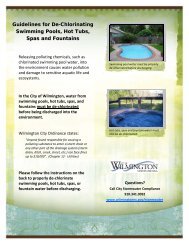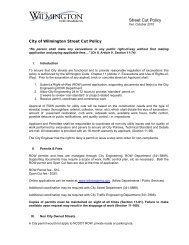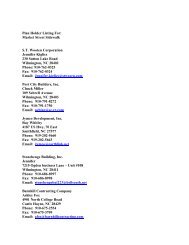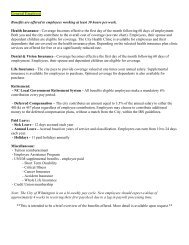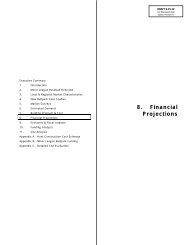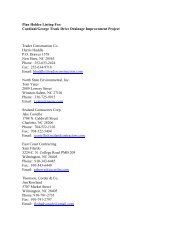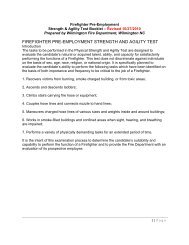article 5. zoning district regulations - City of Wilmington
article 5. zoning district regulations - City of Wilmington
article 5. zoning district regulations - City of Wilmington
You also want an ePaper? Increase the reach of your titles
YUMPU automatically turns print PDFs into web optimized ePapers that Google loves.
Land Development Code<br />
<strong>City</strong> <strong>of</strong> <strong>Wilmington</strong><br />
Sec. 18-200. AI, Airport Industrial District.<br />
(a) Purpose. This <strong>district</strong> is established as a restricted industrial <strong>district</strong> in<br />
which the principal use <strong>of</strong> land is for intensive and extensive commercial and/or<br />
industrial operations that are compatible with airport facilities. It is designed to<br />
provide sites adjacent to railroads and/or major thoroughfares, as well as sites with<br />
airport access. The <strong>district</strong> is intended to protect and promote the public utility <strong>of</strong> the<br />
airport by encouraging compatible land uses to locate proximate to it. It is also<br />
intended to promote the health, safety and welfare <strong>of</strong> area residents by preventing the<br />
creation <strong>of</strong> hazards to the airport, thereby protecting the lives and property <strong>of</strong> the<br />
users <strong>of</strong> the airport and occupants in the vicinity. The restriction <strong>of</strong> uses also serves to<br />
prevent the destruction or impairment <strong>of</strong> the utility <strong>of</strong> the airport and the public<br />
investment therein.<br />
(b) Lot Size One (1) acre minimum lot size.<br />
(c) Access. To protect and promote existing or future residential development,<br />
any means <strong>of</strong> direct access to or from any permitted or special use in the AI, Airport<br />
Industrial District shall not be through any residentially zoned or developed area or<br />
along any street or road in any residential subdivision. If it can be demonstrated that<br />
undue hardship will exist if this provision is strictly enforced, the <strong>zoning</strong> board <strong>of</strong><br />
adjustment may grant a variance in accordance with Article 2 <strong>of</strong> this chapter.<br />
(d) Special requirements. The table below presents the requirements which<br />
shall be met for specified hazards generated.<br />
Hazards<br />
Generated<br />
Dirt, dust, fly<br />
ash, and<br />
particulate<br />
matter<br />
Glare and<br />
heat<br />
Lighting<br />
Noise<br />
Odor<br />
Radio and<br />
electronic<br />
emissions<br />
Requirements and/or Standards<br />
Environmental Protection Agency (EPA) emission levels<br />
Federal Aviation and Administration (FAA) visual hazards<br />
Activities shall be within an enclosure and shall be imperceptible<br />
beyond the property without instruments.<br />
Pulsating, flashing, oscillating or other types <strong>of</strong> attention-getting<br />
device are prohibited. Lighting devices, such as flood lights and<br />
spot lights shall be so arranged or shielded as not to cast<br />
illumination in an upward direction above an imaginary line<br />
extended from a light source parallel to the ground.<br />
EPA decibel levels<br />
Occupational Health and Safety Administration standards<br />
EPA standards<br />
Federal Communications Commission (FCC) license or authority<br />
for operation. FCC and FAA requirements apply to use.<br />
ARTICLE <strong>5.</strong> ZONING DISTRICT REGULATIONS Page 107



